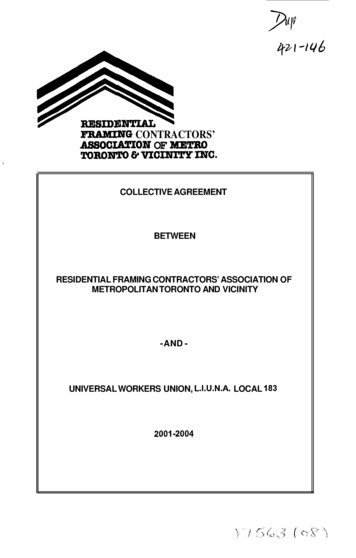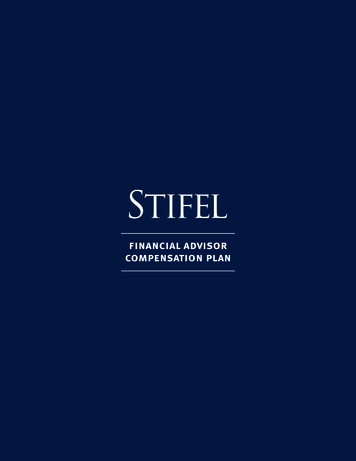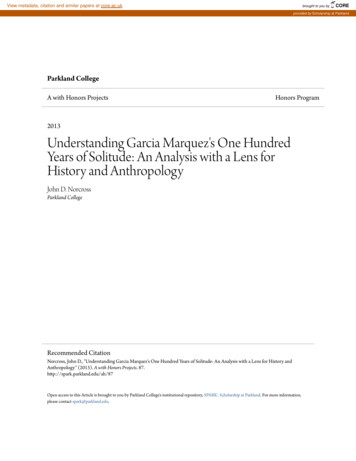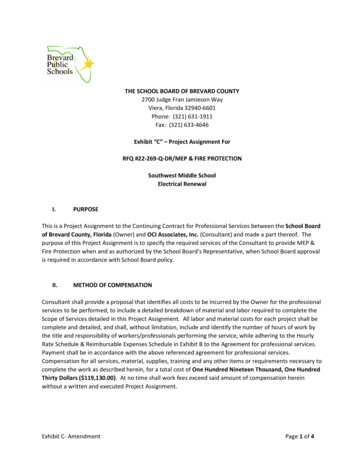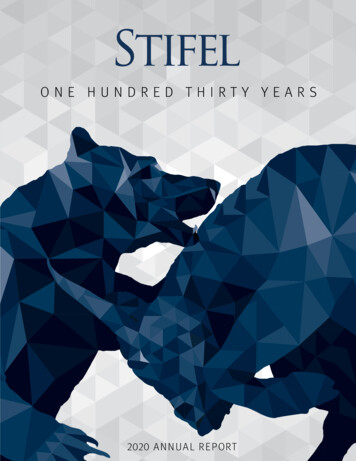
Transcription
ONE HUNDRED THIRTY YEARS2020 A N N UA L R E PORT
ABOUT STIFELPut simply, Stifel is a growth company.From our founding in 1890 through the late 1990s,Stifel was primarily a Midwestern brokerage firmproviding investment advice to individuals. Sincethe late 1990s, through strategic hiring and a seriesof acquisitions, Stifel has transformed itself to whereit is today, a diversified wealth management andinvestment banking firm, operating through a numberof brands, subsidiaries, and broker-dealers – Stifel,Nicolaus & Company, Incorporated, Stifel Bank & Trust,KBW, Miller Buckfire, Eaton Partners, Stifel NicolausCanada Inc., and Stifel Nicolaus Europe Limited, toname a few. Stifel has grown, and is built, around thestrength and commitment of an increasingly diversegroup of like-minded entrepreneurial professionals.Together we now serve a broad group of clients –individuals, institutions, municipalities, andcorporations – providing a wide array of services,ranging from investment advice, securities brokerage,lending and trust services, debt and equity capitalraising, strategic advice, and restructuring, acrossmultiple geographies.Although we operate under different Stifel brands,we collaborate across business units, functions, andgeographies to deliver differentiated capabilities toour clients and guidance to our associates. We areconnected through a common infrastructure and, mostimportantly, a common principle that has guided Stifelthroughout its history – “Safeguarding the moneyof others as if it were your own.” As our businesshas grown and evolved, this enduring principle hasremained constant.STATEMENT OF COMMITMENTTO OUR ASSOCI ATES:current and future, our commitment is to providean entrepreneurial environment that encouragesunconfined, long-term thinking. We seek to rewardhard-working team players that devote their energyand attention to client needs. At work, at home,and in your communities, we seek to be your Firmof Choice.TO OUR CLIENTS:individual, institutional, corporate, and municipal,our commitment is to listen and consistentlydeliver innovative financial solutions. Putting thewelfare of clients and community first, we strive tobe the Advisor of Choice in the industry. Pursuitof excellence and a desire to exceed clients’expectations are the values that empower ourCompany to achieve this status.TO OUR SHAREHOLDERS:small and large, our commitment is to create valueand maximize your return on investment throughall market cycles. By achieving the status of Firm ofChoice for our professionals and Advisor of Choice forour clients, we are able to deliver shareholder valueas your Investment of Choice.INVESTMENTOF CHOICEOFCHOICEADVISOROF CHOICEFIRMOF CHOICE
FINANCIAL HIGHLIGHTSOPERATING RESULTS:20162017201820192020 2,996,462 173,496 1.43 323,383 2.66 3,194,957 384,593 3.15 429,442 3.52 3,514,961 431,077 3.66 479,636 4.07 3,817,839 476,211 4.16 522,847 4.5620162017201820192020 19,129,356 2,738,408 25.89 21,383,953 2,861,576 25.51 24,519,598 3,167,593 28.41 24,610,225 3,614,791 32.24 26,604,254 4,238,766 35.91in thousands, except per share amounts 2,642,370Total Revenues 77,614Net Income Available to Common Shareholders1 0.67Earnings Per Diluted Share2 185,705Non-GAAP Net Income1,2 1.59Non-GAAP Earnings Per Diluted ShareFINANCIAL POSITION:in thousands, except per share amountsTotal AssetsShareholders’ EquityBook Value Per Share112Per share information adjusted for December 2020 three-for-two stock split.Non-GAAP net income and non-GAAP earnings per diluted common share represent GAAP net income and GAAP earnings per diluted common share adjusted for:(1) acquisition-related charges other than duplicative expenses; (2) litigation-related expenses; (3) actions taken by the Company in response to the taxlegislation that was enacted in the fourth quarter of 2018 to maximize tax savings; (4) the favorable impact of the adoption of new accounting guidance during2017 associated with stock-based compensation; and (5) the revaluation of the Company’s deferred tax assets as a result of the enacted tax legislation. SeeReconciliation of GAAP net income to non-GAAP net income on page 22.TOTAL REVENUES01,0002,0003,000NON-GAAP EARNINGSPER DILUTED SHARE 1,2NON-GAAP NET INCOME 2(In millions)(In 19202020TOTAL ASSETS(In millions)06,75013,500SHAREHOLDERS’ EQUIT Y(In millions)020,250 27,0002,1501,0753,2252.503.755.00BOOK VALUE PER SHARE 027.0036.00
SHAREHOLDER LETTERThrough the prism of Stifel, this letter should be an easy andcelebratory recounting of the year. 2020 marked a milestone,as Stifel celebrated its 130th year, a remarkable achievementfor any company, yet especially impressive for a financialservices company. I could write pages describing our 2020achievements, but will summarize as follows: Record revenue of 3.8 billion, up 12%, and representingStifel’s 25th consecutive year of record net revenue. Record non-GAAP net income of 523 million, or 4.56 per diluted common share. Return on tangible equity of 25%. Stifel stock price closed at 50.46, up 25%.In 2020 more than ever, our success depended on thediversification of our business model and the talent of ourmore than 8,500 associates. We successfully integrated thesix acquisitions from 2019, invested in technology, increasedclient access to investment opportunities, improved ourservice capabilities, and built upon our recruiting success.Most impressively, in a matter of days at the beginning ofthe pandemic, over 90% of our associates were seamlesslytransferred to remote access, allowing uninterrupted serviceto Stifel clients. This transition, which impacted eight globaltrading venues, is a demonstration of our flexibility as anorganization and culture of teamwork.RONALD J. KRUSZEWSKIChairman of the Board and Chief Executive OfficerIn my nearly 25 years as CEO of Stifel, this may be my most difficult shareholder letter because, for many, 2020 was atumultuous and difficult year. While the year will be forever etched in history as the year of the pandemic, there is no simpleway to summarize or condense it. The story of 2020 is not a simple one, and it is not just about COVID-19. The year alsowitnessed social unrest, the wildfires in California, a heightened awareness for environmental, social, and governance issues(ESG), and an election that did more to divide than unite our great country.Stifel’s record results set against this backdrop of adversity, uncertainty, and unrestis what makes this letter so hard to write. As individuals, we have all been affectedby the events of this year. Alongside the rest of the nation, we have all sufferedloss, we have all witnessed the struggles of our local communities and businesses,and we have all opened our eyes anew to persistent issues of social justice. Yet asa firm, Stifel has been resilient, and in many ways we have thrived. I acknowledgethat disparity, and I recognize that part of the explanation is structural. Demand forour services, taken collectively, simply did not decline during the pandemic the wayit did for many other businesses. Nonetheless, I believe this good fortune is only asmall part of the picture. Our resilience is primarily drawn from our culture, from theindependence and entrepreneurship of all our associates. Without their spirit, wewould have been unable to navigate the uncertainty of this year.resilience is primarily“ Ourdrawn from our culture,from the independenceand entrepreneurship ofall our associates. Withouttheir spirit, we would havebeen unable to navigate theuncertainty of this year.”2020 FINANCIAL PERFORMANCE2020 was a volatile year for equity markets. In March, as the impact of the pandemic began to crystallize, the S&P 500 indexdeclined 31% as measured from the beginning of the year. Unprecedented fiscal and monetary stimulus proved an effectiveantidote to market concerns, providing a catalyst for the S&P 500 to recoup its losses by August and finish the year upapproximately 16%.2
Stifel stock followed a similar trajectory for the year. During the same month of March, Stifel stock hit an annual low of 20.75,as adjusted for the December 2020 three-for-two stock split, which was down 49% from the beginning of 2020. It thenexperienced a 143% recovery – outpacing both the broader market and our peers, as identified in our proxy. At year-end, Stifelstock stood at 50.46, an increase of 25% for the year. As we prepare this annual letter in March 2021, our stock traded as highas 68.94, which was up 37% from year-end, reflecting both the improved economic outlook and growing market recognition ofour relative valuation.2020 SF PERFORMANCE VS. PEERS30%SF Common Stock25%S&P 500 Index20%16%15%Peer Group10%0%-10%-20%-30%-40%Dec. 19Mar. 20Jun. 20Sep. 20Dec. 20Looking back, if I had predicted in March 2020 that Stifel would have a record year, it would have been hard to believe.The pandemic was worsening, and its economic effects were buffeting our net interest and advisory businesses – two of ourexpected growth drivers. However, Stifel reacted quickly to the outbreak and its market impact, generating record results inour trading, capital-raising, and mortgage origination businesses that more than offset the declines elsewhere. As a result,it was a record year for the firm and for both of our primary operating segments. Global Wealth Management, which accountedfor approximately 58% of our overall revenue, achieved record revenue of 2.2 billion, an increase of 3%. Our Institutionalbusiness, reflecting the investment of prior years, achieved record profitability and revenue, with revenues increasing 30% to 1.6 billion. Across the firm, our response to the challenges of 2020 showcased the strength and diversity of our businessmodel and of our associates.Our co-presidents, Victor Nesi and Jim Zemlyak, provide a more detailed financial assessment of 2020 in their “Year in Review”later in this report.OUR COMMITMENT TO ENVIRONMENTAL, SOCIAL, AND GOVERNANCE PROGRESSIn 2020, we continued to make meaningful progress on ESG issues, importantpillars that affect everyone, not only in business, but in everyday life. As wecelebrate our 130th anniversary, a testament to sustainability, we underscoreour responsibility to provide a diverse and welcoming environment for ourassociates. We also recognize our duty to contribute to the sustainableeconomic development of the communities in which we operate and societyas a whole. At Stifel, we are committed to doing our part to address the manychallenges of ESG. Transparency is an important factor, and we are examiningapproaches to expand our disclosures to better meet recognized frameworkssuch as those of the Sustainable Accounting Standards Board and the TaskForce on Climate-Related Financial Disclosures. Also, we believe that we need toboth act and increase transparency on issues such as diversity and inclusion,ethics and integrity, risk management, and sustainable finance. I believe thatthe incorporation of ESG into our business philosophy and policies is not onlygood for our business but, more importantly, the right thing to do.As we celebrate our 130th“anniversary,a testament tosustainability, we underscoreour responsibility to providea diverse and welcomingenvironment for our associates.We also recognize our duty tocontribute to the sustainableeconomic development of thecommunities in which we operateand society as a whole.”I encourage our shareholders to find out more about our commitments to ESG by reading our 2021 proxy and the informationthat follows within this annual report.3
SHAREHOLDER LETTERMOVING FORWARD, BACK TO THE OFF ICEOne of the few silver linings of the pandemic is that it spurred us to adopt new tools and technologies for the workplace.I am impressed with the determination shown by our associates this year, using all their resources – and quickly adoptingnew ones – to overcome the myriad obstacles to doing business in the face of COVID-19. That we were able to service clientsand manage volatile markets, even with most of our associates working remotely, underscores the dedication of our people,the comprehensiveness of our business continuity plans, and the flexibility of our technology platform. To the people of Stifel,I say thank you.But now, even after the demonstrated success of remote work, we must plan for life after COVID-19. There is no doubt inmy mind about the importance of physically working together. The benefits are clear – in training, collaborating, innovating,networking, and more. It is simply the best way to continue to build on our culture. As I write this letter, our country is in theprocess of vaccination and I can see life returning to some normalcy, although not yet to completely pre-pandemic conditions.For Stifel, this will include a return to our offices. Rest assured, I am committed to ensuring that this occurs in a safe andfair manner.GOVERNMENT SPENDING AND THE RISK OF INFLATIONI would be remiss if I didn’t discuss the impact of fiscal and monetary policy. In the short term, the CARES Act, combinedwith the additional stimulus in January, the American Rescue Plan Act of 2021, and the Biden administration’s proposedinfrastructure bill, together total nearly 6.5 trillion. That is approximately one-third of U.S. GDP. This stimulus, which constituteswar-level spending, is nine times larger than the Obama-era American Recovery and Reinvestment Act of 2009. Coupled withvery accommodative monetary policy, this level of government spending has, in my opinion, more than offset the negative dragon our economy resulting from COVID-19.So, upon reflection, it should be little surprise that the markets, and many asset classes, have surged in value. On the otherside of the ledger, credit spreads are historically compressed due to accommodative policy. Looking toward the back half of2021, assuming effective vaccination, there is a high probability of excess demand as people use their savings and stimulusto consume. Combined with renewed business investment, this excess may lead to upward price pressures.So what is there to worry about? In my experience, when I am told that certain risks are low and can be managed, those arethe risks that have the potential to be most disruptive if the consensus is proven wrong. Today, and frankly for the last decade,markets seem convinced that inflation poses little risk, and that we have sufficient tools to combat increasing inflationexpectations when they arise. Without doubt, the Fed can manage short-term rates and adjust quantitative easing, and it haspublicly stated its intention to keep rates low while allowing inflation to run above its stated goal of 2%. However, longer-termTreasury yields will adjust independently and have greater effect on the equity markets, especially on high-growth stocks. Asseen on the Bloomberg screen blinking before me, expectations right now indicate sharper rate increases, evidenced in theyields on inflation-protected Treasuries, often referred to as real yields. Therefore, as is always the case, be cognizant of longerterm yields as they relate to equities.THE SOCIAL SIDE OF INVESTINGAs markets evolve, some things never change. As an example, take thestrange saga of GameStop (“GME”), which seems to represent one of thosegrand, confounding collisions of technology and culture. With the very ideaof a “meme stock,” the dwellers of Reddit’s r/wallstreetbets forum have shownus the possibility of a strange new mingling of social media and financialmarkets. Meanwhile, with “free” online trading apps in hand, anyone can jointhe speculation as easily as playing fantasy football. The optimist in me wantsto see these trends mature, to see them live up to the promise of democratizinginvesting while increasing general financial literacy. The realist in me fears thatwe will see little more than the occasional speculative flare-up – fueled by thesavings of those who can afford it least. To me, the most important thing toremind people is not to get caught up in the fear of missing out. Despite thenew technologies, apps, and platforms involved, the core story of GME is avery old one, and the ending never changes.4optimist in me wants to“seeThethesetrends mature, to seethem live up to the promise ofdemocratizing investing whileincreasing general financialliteracy. The realist in mefears that we will see littlemore than the occasionalspeculative flare-up – fueledby the savings of thosewho can afford it least.”
THE CURRENCY OF CRYPTOAs speculative activity and freely available liquidity have surged, cryptocurrencies such as Bitcoin have also sharplyincreased in price. Speculative swings aside, their utility as a currency and an investment vehicle varies around the world.Some countries, including China and India, place strict restrictions on their use, while others, like the United States, view eachcryptocurrency transaction – whether for goods, services, or in exchange for national currency – as a taxable event. At thesame time, Bitcoin mining consumes an ever-larger proportion of global electricity, with one recent report stating that itselectricity consumption equals that of Pakistan, which has a population of 216 million. At that level of inefficiency, it is unclearwhether cryptocurrencies are suitable for ESG investment goals. Still, cryptocurrencies and especially blockchains are agenuine financial innovation. They allow decentralized, distributed entities to come to consensus about transactions andownership in a way that was not possible before. It is not their novelty that is in question, but the scope of their usefulness,and their general applicability as a currency and an investment. In the meantime, while they are so rapidly evolving andso fiercely competing with one another, their volatility must limit their portfolio suitability.Whether we are talking about the next Amazon, the trade-offs of crypto, or the latest scheme on social media, investors todayface an astounding menu of investment opportunities – and just as many potential pitfalls. In our business, we must decidehow we will use technology to help people manage it all. First and foremost, I believe we have a responsibility not to usetechnology to inflame exuberance about new ideas. However glad we are to see a new generation’s evolving perspective oninvesting, our goal is not to make it easier for them to pile into and rush out of speculative meme stocks. Rather, technologycan help people get organized, increase their access to advice and research, and guide them in evaluating an ever-growingpanoply of opportunity. At Stifel, we are investing in technology that helps people make sound decisions and lay stablefoundations for the future, which means knowing when to say “yes” to a new idea – and more importantly, when to say “no.”130 YEARS AND COUNTINGIn conclusion, as I began, I want to emphasize theimportance of our people and culture. When we lookback on the trial that was 2020, our success will foreverbe a testament to the resiliency of our culture – the sameculture of adaptability and independence that has seen usthrough the other great hardships of our 130-year history.Through the influenza pandemic of 1918, two world wars,the Great Depression, the Great Recession, and more, wehave continued to be successful not because we standapart, nor because we are somehow immune to thestruggles of the nation as a whole. We are successfulbecause we can change – and change withoutFrom our humble beginnings in 1890compromising our core values of independence andto where we are todayentrepreneurship. In fact, those values demand thatwe be always changing, always adapting, and alwaysevolving. That is why each of our associates has the power to think independently, to raise issues, and to challenge thewisdom and folly of the status quo. This year has been a test of our ability to use that power not only to respond to crisis, butalso to look critically at our own biases and inequities. Our success thus far is nothing more than a call to continue this work,alongside the rest of the nation, into the next year.Finally, I would like to thank Jim Oates, who has informed me of his intention to retire, for hisnearly three decades of service as a Stifel Director. Jim was instrumental in my decision to joinStifel 25 years ago and has been a reliably fair, thoughtful, and, at times, appropriately criticalvoice. Jim has helped guide Stifel’s incredible growth and has also been a partner and a mentor.I, and our shareholders, will miss his wisdom.As always, we sincerely thank our shareholders and clients for their support, as well as our morethan 8,500 associates for their commitment to excellence.James M. OatesStifel Director Since 1996RONALD J. KRUSZEWSKI5Chairman of the Board and Chief Executive OfficerMarch 2021
YEAR IN REVIEWIn 2020, Stifel reported:2020 RESULTS Record net revenues of 3.8 billion, increased 12.4%compared with 2019.(in thousands, except per share amounts)20202020.% 3,817,8399.9.TOTAL F IRM Record net revenues in Global Wealth Management.Total Revenues Record net revenues and pre-tax operating incomein Institutional Group.Non-GAAP Net IncomeNon-GAAP EPS Record net income available to common shareholdersof 476.2 million, or 4.16 per diluted common share.522,8474.5612.GLOB AL WEALTH MANAGE MENTNet RevenuesContribution Record non-GAAP net income available to commonshareholders of 522.8 million, or 4.56 per dilutedcommon 7.INST I TUTION AL GROUPFor the year ended December 31, 2020, the Company reportednet income available to common shareholders of 476.2 million,or 4.16 per diluted common share, on record net revenues of 3.8 billion, compared with net income available to commonshareholders of 431.1 million, or 3.66* per diluted commonshare, on net revenues of 3.3 billion for the comparable in 2019.The Company reported non-GAAP net income available tocommon shareholders of 522.8 million, or 4.56 per dilutedcommon share. The Company’s reported GAAP net income forthe year ended December 31, 2020, was primarily impacted bymerger-related expenses. Details are discussed below and inthe “Reconciliation of GAAP Net Income to Non-GAAP NetIncome” section.Equity Net RevenuesFixed Income Net RevenuesNet RevenuesContribution652,1 65571,583,1 47325,2853085INSTITUTIONAL BROKERAGEEquity256,79354Fixed Income404,78958Total661 ,58257Equity705,26118Fixed Income247,04713Total952,30817Capital Raising524,16142IN VESTMENT BANKINGWe continuously strive to improve client service and investAdvisory428,1 47(4)in our future, and we are also focused on improving ouroperational efficiency. Four years ago, we articulated a strategyPercent represents the increase/(decrease) over prior year results.to identify costs, savings, and efficiencies, and to further integrateour businesses. These steps have resulted in a meaningful improvement in our non-GAAP performance metrics as comparedto 2016, as our: Compensation ratio improved to 59.9% vs. 62.8%; Non-compensation expense ratio improved to 21.1% vs. 24.1%; Pre-tax margin improved to 19.0% vs. 13.1%; and Return on tangible equity improved to 24.7% vs. 15%.A clear benefit of our improved financial metrics is the generation of significant cash flow. We remain focused on maximizingrisk-adjusted returns when deploying our capital, yet as a growth company, we believe that investing in our business toenhance our relevance to our clients is essential. In 2020, these investments included the significant hiring of talentedpeople to further expand our revenue base as we fully integrated our six acquisitions from 2019. Furthermore, we continuedto make essential investments in technology to improve the client experience as well as the efficiency of our associates.In addition to focusing on strategic hiring and investments in technology, we utilized the strength of our balance sheet toreturn approximately 185 million to shareholders through dividends, net settlement of restricted stock units, and sharerepurchases. Today, there exists a significant debate, primarily political in nature, about the appropriateness of sharerepurchases. We view share repurchases as an important capital tool, yet understand the importance of buying back stockat a reasonable price. Said another way, share repurchases should add value to remaining shareholders. Of course, weunderstand the policy discussion restricting share repurchases if a company needs government assistance.6
Both of our operating segments had outstanding years. Global Wealth Management achieved record revenue of 2.2 billion,an increase of 3% over 2019. Our Institutional business achieved record revenue of 1.6 billion, up 30% from 2019.GLOBAL WEALTH MANAGEMENTWithin Global Wealth Management, our Private Client Group now consists of nearly 2,300 financial advisors who serve clientsfrom 392 offices across the country. We had a strong year for financial advisor recruiting, opening 16 new Private Client Groupoffices and adding 131 financial advisors from a variety of firms. The success of this group emanates from the entrepreneurialcharacter of each of our financial advisors. As always, our goal is to support them with the tools and resources they need to dowhat they do best: build strong relationships with clients to better define and meet their financial goals.We achieved record results in Global Wealth Management despite the fact that our net interest income and sweep fee incomedeclined by approximately 96 million. Excluding this impact, our full-year wealth management revenue increased 9%, drivenby strong growth in our brokerage and asset management revenues, both which reflect strong recruiting and markets.Our Global Wealth Management business continues to benefit from growth and stability of revenue. As of the end of 2020, wemanaged approximately 357 billion in client assets, up 9% from 2019. Our assets under administration and fee-based assetswere impacted by the sale of Ziegler Capital Management. Excluding the Ziegler sale, our fee-based assets increased 22%.We continue to grow our technology and digital offerings to create amore efficient and personalized experience for clients and advisors.We’ve ramped up efforts to provide our financial advisors with the mostcutting-edge digital marketing capabilities in the marketplace, usingtechnology to support our advice-based model. We now have a suiteof offerings that enable our advisors to better communicate with theirclients as well as prospects. Stifel Wealth Tracker continues to helpclients and prospects and now features new cash management anddigital banking capabilities. From a client/prospect communicationstandpoint, the app offers proprietary insights and reports from Stifel’sCIO Office and research analysts. We’ve also rolled out powerful new client performance reporting tools and a new CRMimplementation that will enable 100% mobility and fully integrate with our key business applications.Stifel Bancorp ended the year with 18.9 billion in assets while maintaining a conservative risk profile. Stifel Bancorp’s creditmetrics remained solid, with a non-performing asset ratio of 0.07%, an improvement of two basis points from 2019. Our assetquality metrics compare very favorably to the overall market and reflect our conservative approach. Firm-wide assets totaled 26.6 billion, and we ended the year with a Tier 1 leverage ratio of 11.9% and a risk-based capital ratio of 20.2%.INSTITUTIONAL GROUPInvestment Banking revenues totaled 916 million in 2020. Capital-raising revenue totaled a record 524 million, a 42%increase from 2019, while advisory revenue was 428 million.In 2020, a surge in volatility and the significant contraction of economic activity negatively impacted our advisory businessin the early part of the year, particularly in the financials and technology verticals, as well as our fund placement business.Taken alone, these factors without the subsequent pickup might well have led to a decline in revenue from 2019.However, the diversity of our business model, coupled with a rebound in activity in the second half of 2020, enabled usnot only to post another record year, but to surpass the high end of our guidance. This was due to the fact that our 2019acquisitions performed slightly better than we expected, and our investment banking business benefited from the strengthof our healthcare franchise, which more than offset the weakness in financials.On the advisory front, we completed 183 M&A strategic advisory assignments. In terms of verticals, our top performers wereconsumer, industrials, and technology.Noteworthy assignments include serving as financial advisor to Ionis on its 500 millionacquisition of the remaining 24% of Akcea common stock it did not already own; exclusivefinancial advisor to Urban Farmer in its sale to Paine Schwartz Partners; and exclusive advisorto Velocity Technology Solutions Inc. in its sale to Navisite, owned by Madison DearbornPartners. In addition, we won The M&A Advisor’s “Strategic Deal of the Year” Award in the 50 million – 100 million category for advising on the sale of B&G Crane Services.7The M&A Advisor’s“Strategic Deal ofthe Year” Award
YEAR IN REVIEWOur KBW subsidiary posted another solid year despite the headwinds of 2020, advising on three of the top five largest U.S.bank mergers: Huntington Bancshares Incorporated’s merger with TCF Financial Corporation, South State Corporation’s mergerwith CenterState Bank Corporation, and First Citizens BancShares, Inc.’s merger with CIT Group Inc.With respect to equity capital raising, we completed 30 book-run IPOs and 71 book-run follow-ons in 2020. Notabletransactions include serving as joint global coordinator and joint bookrunner to Renalytix on its cross-border IPO; solebookrunner to Inseego on its 100 million convertible senior notes offering;
2 3 Stifel stock followed a similar trajectory for the year. During the same month of March, Stifel stock hit an annual low of 20.75, as adjusted for the December 2020 three-for-two stock split, which was down 49% from the beginning of 2020.




